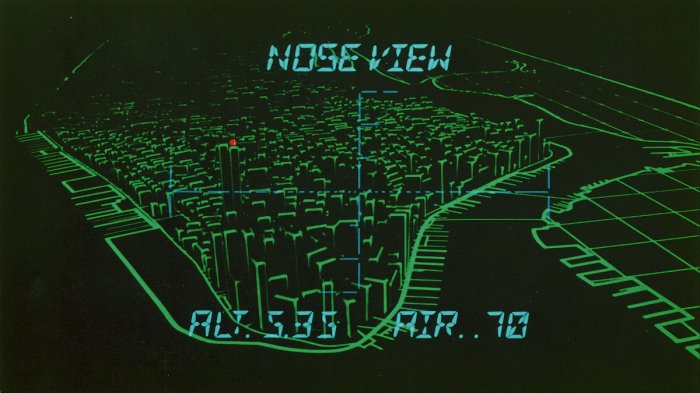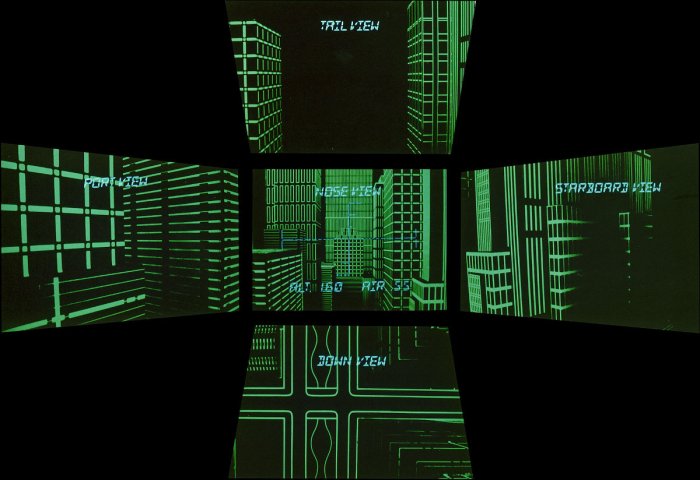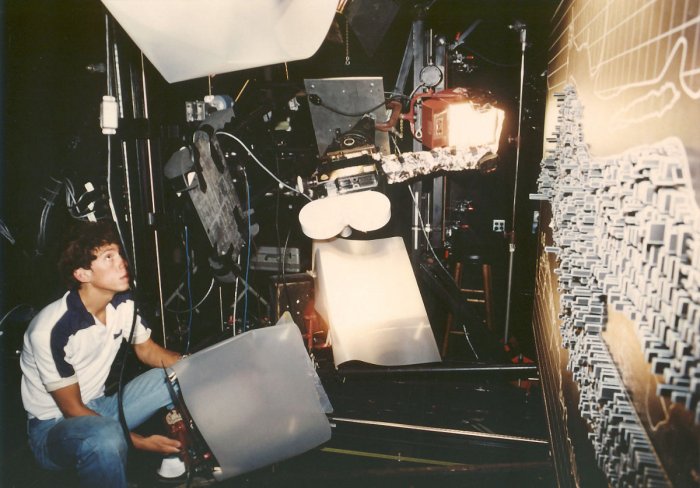Exhibit / February 14, 2017
Object Name: Special visual effects sequence from Escape from New York
Maker and Year: John C. Wash, Mark Stetson, Hoyt Yeatman, Scott Squires, et al., 1981
Object Type: Visual effect
Image Source: The Escape From New York & L.A. Page
Description: (K.E. Roberts)
Escape from New York was John Carpenter’s most ambitious and biggest-budget film to date, and his first choices to handle visual effects were Jim Danforth (7 Faces of Dr. Lao) and John Dykstra, the latter the talk of the special effects world for his Academy Award-winning work on Star Wars (1977). Carpenter knew and respected Danforth, who had painted some mattes for Carpenter’s first film, Dark Star (1975), but Danforth was in the U.K. working with Ray Harryhausen on Clash of the Titans (1981). As for Dykstra and his team, Carpenter met with them, subsequently telling Starlog that they were “outrageous beyond my wildest dreams… I couldn’t believe their price and their attitude… They have the attitude that they’re celebrities, and I don’t understand it.”
Instead, Carpenter opted for Roger Corman’s New World Pictures effects team, which included brothers Bob and Dennis Skotak, along with a pre-Terminator James Cameron. All three had worked together on the Corman-produced Battle Beyond the Stars, producing memorable effects at a bargain price—a Corman requirement. Cameron, for his part, was greatly influenced by Carpenter (and takes credit for getting the Escape from New York gig). The look and grit of Escape from New York is all over The Terminator, and a number of scenes from Aliens (1986) mirror scenes from the Carpenter classic: Hudson (Bill Paxton) getting dragged into the floor by the aliens is a riff on the woman (Season Hubley) in Chock Full O’Nuts getting dragged into the floor by the “crazies,” and “the thing with the knife” that Hudson makes Bishop (Lance Henrikson) do is a direct homage to Dark Star—which, coincidentally, was co-written by and stars Dan O’Bannon, who animated the X-Wing targeting display in Star Wars and went on to write Alien (1979).
Some sources (see here, here, and here) cite Cameron as the brains behind the glider navigation sequence—as Snake Plissken (Kurt Russell) flies a stealth glider into Manhattan Prison, his navigation displays show what appear to be computer-generated wireframe images of New York City—but it was almost certainly John C. Wash, who had worked with Carpenter on Dark Star while both were attending USC film school. After he graduated, Wash was hired by George Lucas to animate a computer sequence in Star Wars—specifically, the display in the Death Star’s war room indicating when Yavin 4 (the location of the rebel base) would enter firing range. Wash describes the Escape from New York sequence in an interview with The Escape From New York and L.A. Page:
To flesh out the scene, Carpenter wanted a high-tech series of displays representing wire frame images to play on monitors in the glider, and in full-screen during the scene. Based on the work I had done on Dark Star, I think John trusted that I could accomplish those shots…
The shots were not, in fact, generated by a computer, as Wash explains:
At that time computer graphics were still in their nascent stage. Most of the computers used to do very simple animations were large, expensive machines reserved for research work at large corporations and universities. In the instance of Plissken’s glider sequence, I knew that a computer model of the island of Manhattan, with hundreds, if not thousands of structures, would be beyond the capacity of any computer that existed then.
So Wash and colleague Mark Stetson built three miniature models of Manhattan that corresponded to Plissken’s flight path. To make the navigation readouts appear on screen as wireframe renderings, the buildings were constructed out of black material, with the edges and corners painted white. Then the models were shot by Hoyt Yeatman (visual effects supervisor on The Fly and James Cameron’s The Abyss) and Scott Squires (visual effects on Willow and The Hunt for Red October), in one instance using a special “snorkel” camera that fit between the buildings in one of the city models. A third-party optical effects company then added graphic overlays to achieve the green on black that was standard visual display on almost all of the computer screens of the day. The rest of the approach sequence was shot using three different glider models and different scale Manhattan miniatures built by the Skotaks, Cameron, and others on the New World Pictures crew.







WOW. That’s crazy!!
Pingback: John Carpenter’s Escape from New York – Retro-Lab
Pingback: Tech-Noir: How One Scene in ‘The Terminator’ Changed Science Fiction
Pingback: Filmography: John Carpenter – MEL AT THE MOVIES
Pingback: A Strange Harvest: Alan Rudolph’s ‘Endangered Species’
Pingback: Key Movies Of My Life: Escape from New York (1981) – Late to the Game Blog
Pingback: “A Closer Look”: HBO Feature Presentation Sequence, 1982
Pingback: Days Without Incident | Escape from New York (dir. by John Carpenter)
Pingback: Escape From New York (dir. by John Carpenter) | Through the Shattered Lens